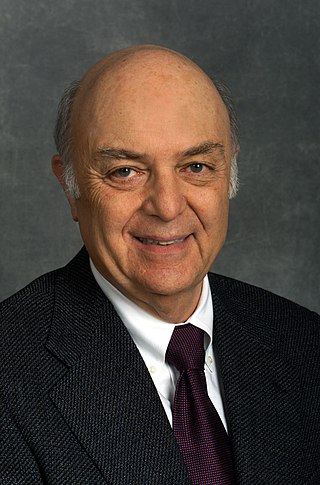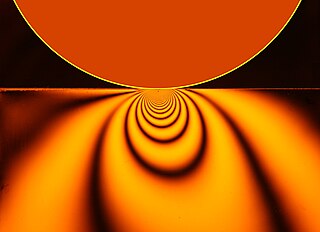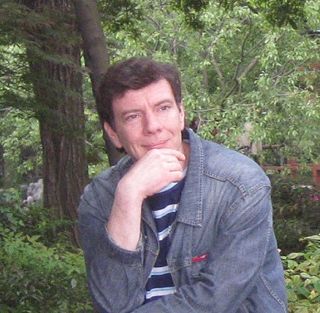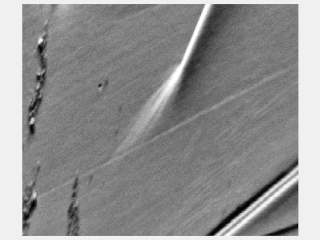Related Research Articles
Continuum mechanics is a branch of mechanics that deals with the deformation of and transmission of forces through materials modeled as a continuous medium rather than as discrete particles. The French mathematician Augustin-Louis Cauchy was the first to formulate such models in the 19th century.
In physics and materials science, elasticity is the ability of a body to resist a distorting influence and to return to its original size and shape when that influence or force is removed. Solid objects will deform when adequate loads are applied to them; if the material is elastic, the object will return to its initial shape and size after removal. This is in contrast to plasticity, in which the object fails to do so and instead remains in its deformed state.
Solid mechanics is the branch of continuum mechanics that studies the behavior of solid materials, especially their motion and deformation under the action of forces, temperature changes, phase changes, and other external or internal agents.
In materials science and continuum mechanics, viscoelasticity is the property of materials that exhibit both viscous and elastic characteristics when undergoing deformation. Viscous materials, like water, resist shear flow and strain linearly with time when a stress is applied. Elastic materials strain when stretched and immediately return to their original state once the stress is removed.
Hysteresivity derives from “hysteresis”, meaning “lag”. It is the tendency to react slowly to an outside force, or to not return completely to its original state. Whereas the area within a hysteresis loop represents energy dissipated to heat and is an extensive quantity with units of energy, the hysteresivity represents the fraction of the elastic energy that is lost to heat, and is an intensive property that is dimensionless.
Jozef T. Devreese was a Belgian scientist, with a long career in condensed matter physics. He was professor emeritus of theoretical physics at the University of Antwerp. He died on November 1, 2023.

A shear band is a narrow zone of intense shearing strain, usually of plastic nature, developing during severe deformation of ductile materials. As an example, a soil specimen is shown in Fig. 1, after an axialsymmetric compression test. Initially the sample was cylindrical in shape and, since symmetry was tried to be preserved during the test, the cylindrical shape was maintained for a while during the test and the deformation was homogeneous, but at extreme loading two X-shaped shear bands had formed and the subsequent deformation was strongly localized.
Harry Leonard Swinney is an American physicist noted for his contributions to the field of nonlinear dynamics.

Marvin Lou Cohen is an American–Canadian theoretical physicist. He is a physics professor at the University of California, Berkeley. Cohen is a leading expert in the field of condensed matter physics. He is widely known for his seminal work on the electronic structure of solids.
Pseudoelasticity, sometimes called superelasticity, is an elastic (reversible) response to an applied stress, caused by a phase transformation between the austenitic and martensitic phases of a crystal. It is exhibited in shape-memory alloys.

Contact mechanics is the study of the deformation of solids that touch each other at one or more points. A central distinction in contact mechanics is between stresses acting perpendicular to the contacting bodies' surfaces and frictional stresses acting tangentially between the surfaces. Normal contact mechanics or frictionless contact mechanics focuses on normal stresses caused by applied normal forces and by the adhesion present on surfaces in close contact, even if they are clean and dry. Frictional contact mechanics emphasizes the effect of friction forces.
Picosecond ultrasonics is a type of ultrasonics that uses ultra-high frequency ultrasound generated by ultrashort light pulses. It is a non-destructive technique in which picosecond acoustic pulses penetrate into thin films or nanostructures to reveal internal features such as film thickness as well as cracks, delaminations and voids. It can also be used to probe liquids. The technique is also referred to as picosecond laser ultrasonics or laser picosecond acoustics.
Emmanuel I. Rashba is a Soviet-American theoretical physicist of Jewish origin who worked in Ukraine, Russia and in the United States. Rashba is known for his contributions to different areas of condensed matter physics and spintronics, especially the Rashba effect in spin physics, and also for the prediction of electric dipole spin resonance (EDSR), that was widely investigated and became a regular tool for operating electron spins in nanostructures, phase transitions in spin-orbit coupled systems driven by change of the Fermi surface topology, Giant oscillator strength of impurity excitons, and coexistence of free and self-trapped excitons. The principal subject of spintronics is all-electric operation of electron spins, and EDSR was the first phenomenon predicted and experimentally observed in this field.

Oreste Piro is a dynamical systems theorist and biophysicist. He is at the Universitat de les Illes Balears (UIB) in Palma de Mallorca.

John Francis Brady is an American chemical engineer and the Chevron Professor of Chemical Engineering and Mechanical Engineering at the California Institute of Technology. He is a fluid mechanician and creator of the Stokesian dynamics method for simulating suspensions of spheres and ellipsoids in low Reynolds number flows. He is an elected fellow of the American Physical Society, a fellow of the Society of Rheology, as well as a member of the National Academy of Sciences, the National Academy of Engineering, and the American Academy of Arts and Sciences.
Surajit Sen is a physicist who works on theoretical and computational problems in non-equilibrium statistical physics and in nonlinear dynamics of many body systems. He holds a Ph.D in physics from The University of Georgia (1990) where he studied with M. Howard Lee. He is also interested in applying physics to study problems of relevance in a societal context. He is a professor of physics at the State University of New York, Buffalo. Much of Sen's recent work can be found in his RUSA lecture at Bharatidasan University.

Vladimir G. Dubrovskii is the head of Laboratory of physics of nanostructures at St. Petersburg Academic University, a leading research scientist at Ioffe Institute, and a professor at St. Petersburg State University and ITMO University.

Fiber network mechanics is a subject within physics and mechanics that deals with the deformation of networks made by the connection of slender fibers,. Fiber networks are used to model the mechanics of fibrous materials such as biopolymer networks and paper products. Depending on the mechanical behavior of individual filaments, the networks may be composed of mechanical elements such as Hookean springs, Euler-Bernoulli beams, and worm-like chains. The field of fiber network mechanics is closely related to the mechanical analysis of frame structures, granular materials, critical phenomena, and lattice dynamics.

Alain Goriely is a Belgian mathematician, currently holding the statutory professorship (chair) of mathematical modelling at the University of Oxford, Mathematical Institute. He is director of the Oxford Centre for Industrial Mathematics (OCIAM), of the International Brain and Mechanics Lab (IBMTL) and Professorial Fellow at St Catherine's College, Oxford. At the Mathematical Institute, he was the director of external relations and public engagement, from 2013 until 2022, initiating the Oxford Mathematics series of public lectures. In 2022, he was elected to the Royal Society.

Slip bands or stretcher-strain marks are localized bands of plastic deformation in metals experiencing stresses. Formation of slip bands indicates a concentrated unidirectional slip on certain planes causing a stress concentration. Typically, slip bands induce surface steps and a stress concentration which can be a crack nucleation site. Slip bands extend until impinged by a boundary, and the generated stress from dislocations pile-up against that boundary will either stop or transmit the operating slip depending on its (mis)orientation.
References
- ↑ E. I. Rashba, Construction sequence dependent stresses in massive bodies due to their weight, Proc. Inst. Struct. Mech. Acad. Sci. Ukrainian SSR 18, 23 (1953).
- ↑ Brown, C. B.; Goodman, L. E. (1963-12-17). "Gravitational stresses in accreted bodies". Proceedings of the Royal Society of London. Series A. Mathematical and Physical Sciences. 276 (1367). The Royal Society: 571–576. doi:10.1098/rspa.1963.0227. ISSN 2053-9169.
- ↑ V. E. Naumov, Mechanics of growing deformable solids: A review, J. Eng. Mech. 120, 207 (1994).
- ↑ J. G. Bentler and J. F. Labuz, Performance of a Cantilever retaining wall, J. Geotech. Geoenviron. Eng. 132, 1062 (2006).
- ↑ Bacigalupo, Andrea; Gambarotta, Luigi (2012). "Effects of Layered Accretion on the Mechanics of Masonry Structures". Mechanics Based Design of Structures and Machines. 40 (2). Informa UK Limited: 163–184. doi:10.1080/15397734.2011.628622. ISSN 1539-7734.
- ↑ S. A. Lychev, Geometric aspects of the theory of incompatible deformations in growing solids, in Mechanics for Materials and Technologies, ed. by H. Altenbach, R. Goldstein, and E.Murashkin, Advanced Structured Materials, 46 (Springer, New York, 2017).
- ↑ Wildeman, Sander; Sterl, Sebastian; Sun, Chao; Lohse, Detlef (2017-02-23). "Fast Dynamics of Water Droplets Freezing from the Outside In". Physical Review Letters. 118 (8). American Physical Society (APS): 084101. arXiv: 1701.06818 . doi:10.1103/physrevlett.118.084101. ISSN 0031-9007.
- ↑ Ge, Qi; Sakhaei, Amir Hosein; Lee, Howon; Dunn, Conner K.; Fang, Nicholas X.; Dunn, Martin L. (2016-08-08). "Multimaterial 4D Printing with Tailorable Shape Memory Polymers". Scientific Reports. 6 (1). Springer Science and Business Media LLC: 31110. doi: 10.1038/srep31110 . ISSN 2045-2322. PMC 4976324 .
- ↑ R. R. Archer, Growth Stresses and Strains in Trees, Springer Series in Wood Science (Springer-Verlag, Berlin, 1987)
- ↑ Dafalias, Yannis F.; Pitouras, Zacharias (2007-12-06). "Stress field in actin gel growing on spherical substrate". Biomechanics and Modeling in Mechanobiology. 8 (1). Springer Science and Business Media LLC: 9–24. doi:10.1007/s10237-007-0113-y. ISSN 1617-7959.
- ↑ Truskinovsky, Lev; Zurlo, Giuseppe (2019-05-03). "Nonlinear elasticity of incompatible surface growth". Physical Review E. 99 (5). American Physical Society (APS): 053001. arXiv: 1901.06182 . doi:10.1103/physreve.99.053001. ISSN 2470-0045.
- ↑ Zurlo, Giuseppe; Truskinovsky, Lev (2017-07-26). "Printing Non-Euclidean Solids". Phys. Rev. Lett. 119 (4). American Physical Society (APS): 048001. arXiv: 1703.03082 . doi:10.1103/PhysRevLett.119.048001. ISSN 2470-0045.
F. Sozio, M.F. Shojaei, S. Sadik, and A. Yavari, Nonlinear mechanics of thermoelastic accretion, \emph{Zeitschrift f\"ur Angewandte Mathematik und Physik (ZAMP)} \textbf{71}(3), 2020, 87.
F. Sozio and A. Yavari, Nonlinear mechanics of accretion, \emph{Journal of Nonlinear Science} \textbf{29}(4), 2019, 1813-1863.
F. Sozio and A. Yavari, Nonlinear mechanics of surface growth for cylindrical and spherical elastic bodies, \emph{Journal of the Mechanics and Physics of Solids} \textbf{98}, 2017, pp. 12-48.